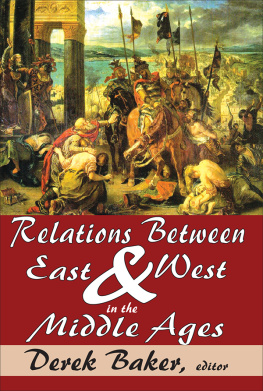CULTURAL
PATTERNS AND
NEUROCOGNITIVE
CIRCUITS
EastWest Connections
Exploring Complexity
| Series Editor: | Jan Wouter Vasbinder
Director, Complexity Program
Nanyang Technological University |
Editorial Board Members: |
Geoffrey B. West, Santa Fe Institute
John Steve Lansing, Nanyang Technological University
Robert Axtell, George Mason University |
For four centuries our sciences have progressed by looking at its objects of study in a reductionist manner. In contrast complexity science, that has been evolving during the last 3040 years, seeks to look at its objects of study from the bottom up, seeing them as systems of interacting elements that form, change, and evolve over time. Complexity therefore is not so much a subject of research as a way of looking at systems. It is inherently interdisciplinary, meaning that it gets its problems from the real non-disciplinary world and its energy and ideas from all fields of science, at the same time affecting each of these fields.
The purpose of this series on complexity science is to provide insights in the development of the science and its applications, the contexts within which it evolved and evolves, the main players in the field and the influence it has on other sciences.
| Volume 1: | Aha.... That is Interesting!
John Holland, 85 Years Young
edited by Jan W Vasbinder |
| Volume 2: | Cultural Patterns and Neurocognitive Circuits:
EastWest Connections
edited by Jan W Vasbinder & Balzs Gulys |
Published by
World Scientific Publishing Co. Pte. Ltd.
5 Toh Tuck Link, Singapore 596224
USA office: 27 Warren Street, Suite 401-402, Hackensack, NJ 07601
UK office: 57 Shelton Street, Covent Garden, London WC2H 9HE
British Library Cataloguing-in-Publication Data
A catalogue record for this book is available from the British Library.
Exploring Complexity Volume 2
CULTURAL PATTERNS AND NEUROCOGNITIVE CIRCUITS EastWest Connections
Copyright 2017 by World Scientific Publishing Co. Pte. Ltd.
All rights reserved. This book, or parts thereof, may not be reproduced in any form or by any means, electronic or mechanical, including photocopying, recording or any information storage and retrieval system now known or to be invented, without written permission from the publisher.
For photocopying of material in this volume, please pay a copying fee through the Copyright Clearance Center, Inc., 222 Rosewood Drive, Danvers, MA 01923, USA. In this case permission to photocopy is not required from the publisher.
ISBN 978-981-3147-48-5
Printed in Singapore
Contents
J. Vasbinder and B. Gulys
J. H. Holland
J.-P. Changeux
S. Gielen
S. Kri
C. Plh
E. Pppel and Y. Bao
7When Brains Design/Experience Buildings: Architectural
Patterns for a Good Life
M. A. Arbib
S. E. Larsen
A. H. Y. Ho and G. Tan-Ho
10Is Consciousness a Riddle Wrapped in a Mystery inside an
Enigma? Mysterianism and Beyond
R. Vergauwen
Introduction
Jan Vasbinder and Balzs Gulys
Oh, East is East, and West is West, and never the twain shall meet, Till Earth and Sky stand presently at Gods great Judgment Seat; But there is neither East nor West, Border, nor Breed, nor Birth, When two strong men stand face to face, though they come from the ends of the earth!
The Ballad of East and West
Rudyard Kipling (1889)
East and West, two major worlds of aspirations, cultures, world-views, theoretical and practical approaches to life and death, are in the focus of the exploratory activities of Para Limes, which already started a systematic exploration of the similarities and differences between the cultural-cognitive-behavioural-emotional patterns of the East and the West, with special regard to their neurobiological underpinnings in the human brain.
A question, which is raised often by each and every individual on Earth, namely What, in the thoughts and heart of an individual person, makes his/her life worth living? is also coming into the fore among the topics to be explored by the Para Limes Institute, as this question is often asked but rarely answered in a meticulous scientific manner. In this spirit, the present workshop would explore various aspects of a good life, including cultural, neurocognitive, emotional aspects as well as the Eastern and Western approaches, and it will focus on cultural patterns and cognitive patterns in the East and West, with special regard to those patterns which are determined by our natural-genetic endowments in contrast to those patterns which are influenced by our cultural (East-West) influences. Within this context, a unique flavour will be given during the talks and discussion to a good life, a life worth living aspects.
In line with the aspirations of Para Limes, with the present workshop we intend to continue our interdisciplinary and intercultural approach in which boundaries of disciplines and institutes should not limit the scope of the individual talks or the discussions. Hence we have invited speakers from fundamentally different fields to make sure we have mind boggling -mind broadening discussions.
Common sense is the most fairly distributed thing in the world, for each one thinks he is so well-endowed with it that even those who are hardest to satisfy in all other matters are not in the habit of desiring more of it than they already have.
The Para Limes Institute at Nanyang Technological University is dedicated to exploring complexity by going beyond the boundaries of disciplines, cultures and institutions. In this spirit, Para Limes has initiated exploratory projects by teams of world-class scientists, philosophers, artists, policy makers, and men and women of practice and it has already organised a series of conferences on various interdisciplinary themes, related to its mission.
Prof John H. Holland died on August 9, 2015. He was an explorer and a pioneer who established complexity research as a new field of science. He was blessed with an inexhaustible flow of original ideas. His work and views on complex adaptive systems, computation, evolution and cognition have influenced a broad field of sciences, as varied as psychology, neuroscience, economics and linguistics.
The lecture Cycles and Hierarchies he gave at the conference East West connections, cultural circuits in the brain was his last public lecture. He did not have time anymore to write up the paper for this book.
To honor him we have transcribed the videotape we made of his lecture and included the text, together with the figures he presented during his lecture, in this volume.











